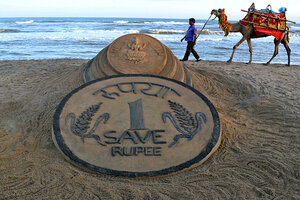What happened to India's economic miracle?
The Indian rupee and the Bombay stock exchange are falling fast. In only a couple years, India went from 10 percent growth talk to barely 5 percent growth.

An Indian walks past a sand sculpture of a rupee coin on a beach in Puri, India, Thursday, Aug. 22, 2013. The Indian rupee has fallen 16 percent against the US dollar since May, and the Bombay stock exchange is down to an 11-month low.
AP
New Delhi
Just two years ago Indian economists were gushing about the country’s “double-digit growth” and the Indian media would regularly use the self-congratulatory term “the India story” or the “economic miracle.” Now, rising India suddenly seems to have a gloomy economic outlook.
Economic growth has slowed to around 5 percent, car sales are showing negative growth for the first time in 12 years, the Indian rupee has fallen 16 percent against the US dollar since May, and the Bombay stock exchange is down to an 11-month low. A ballooning current account deficit (in which the government imports more than it exports) has some comparing it to the economic crisis of 1991.
Though India is not the only emerging economy to take a hit as the US experiences economic revival, its economy has taken a more serious hit than any of the other BRIC (Brazil, Russia, India, and China) economies. Analysts blame India’s internal politics.
The current government, led by economist Manmohan Singh, has been characterized by a “policy paralysis” since 2010, thanks largely to one corruption scandal after another.
“I think the turning point was the 2G scam,” says political commentator Ajoy Bose, referring to one of India’s largest financial corruption cases, which, he says, put the government on the defense. “The political crises have left the government with little space to maneuver, and it is afraid to take economic decisions that might politically backfire.”
The paralyzed government has been unable to attract investment, and several economic legislations are pending in the parliament. Key among them is a new land-acquisition law.
"It's a volatile market right now. Investors are waiting to invest but will hold on until the 2014 general elections. No matter who forms the next government, it is expected to be stable and politically strong enough to be able to push through policies to boost growth," says Rajat Sharma, a Mumbai-based equity research analyst.
Economist Surjit Bhalla blames the economic gloom on the government’s efforts to garner public support by applying popular policies at the cost of economic sense.
“Around 2006-07, the government started raising the administered minimum support price for procuring food-grains from farmers. This was raised 35 percent in three years. This is why India's inflation continues to be high even though global inflationary pressure declined after 2009,” Mr. Bhalla says.
Economists say the falling rupee is expected to affect India's large fuel import bill negatively and lead to further inflation. The government sees the numbers differently.
"Growth slowed down to 5 percent in 2012-13 and we expect that the growth trend will remain flattish in the first quarter; but even so, we are in better health than many other countries in the world,” India’s finance minister, P. Chidambaram, said today, adding, "Therefore there is no reason for excessive or unwarranted pessimism. We expect that growth will pick up in Q2 to Q4."
But analysts see such optimism as wishful thinking.
"There's a complete lack of trust. No one is going to put money [into India] until a new government is in place," says Devangshu Datta, market analyst and editor of Indian Infrastructure. "There's a complete collapse of investment and consumer demand and it is unlikely to look up, despite the government trying to make things a little easier," he says.

